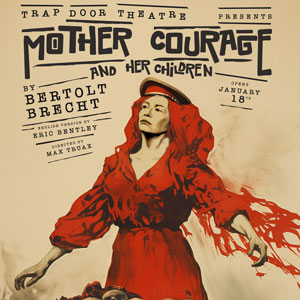
 [rating=4]Directed by conductor Patrick Dupre Quigley, the Music of the Baroque orchestra—in this one-of-a-kind concert—paid tribute to “baroque heroes” from all different musical walks of life. The Sunday afternoon performance at the North Shore Center for the Performing Arts honored three types of heroes: first, those who wrote some of the most beautiful music of this time period. We can include Johannes Sebastian Bach and his son Carl Philipp Emanuel Bach on that list. Then there are the composers who crafted music around fictional heroes of the past. Georg Phillip Telemann devoted his six-part musical burlesque to that chaser of windmills Don Quixote, of Spanish literary fame, while Jean-Phillippe Rameau crafted his Suite from “Castor et Pollux” from well-known story of two twin boys, taken from the mythology of Ancient Rome. Finally, Michael Praetorius was a hero in his own right not just by writing his own music (most notably his set of 312 secular dances called “Terpsichore”) but by compiling and categorizing musical compositions, performances, and instruments from the German Renaissance through the Baroque period into a compendium, so as to provide a knowledge base so that future generations could research the music of that era.
[rating=4]Directed by conductor Patrick Dupre Quigley, the Music of the Baroque orchestra—in this one-of-a-kind concert—paid tribute to “baroque heroes” from all different musical walks of life. The Sunday afternoon performance at the North Shore Center for the Performing Arts honored three types of heroes: first, those who wrote some of the most beautiful music of this time period. We can include Johannes Sebastian Bach and his son Carl Philipp Emanuel Bach on that list. Then there are the composers who crafted music around fictional heroes of the past. Georg Phillip Telemann devoted his six-part musical burlesque to that chaser of windmills Don Quixote, of Spanish literary fame, while Jean-Phillippe Rameau crafted his Suite from “Castor et Pollux” from well-known story of two twin boys, taken from the mythology of Ancient Rome. Finally, Michael Praetorius was a hero in his own right not just by writing his own music (most notably his set of 312 secular dances called “Terpsichore”) but by compiling and categorizing musical compositions, performances, and instruments from the German Renaissance through the Baroque period into a compendium, so as to provide a knowledge base so that future generations could research the music of that era.
The program began with six dances from “Terpsichore”, as performed by the South Chicago Dance Theatre and brilliantly choreographed by Kia S. Smith. Borrowing from French and German styles, this set of modern dances featured eight performers—Kelly Anderson, Amaya Arroyo, Mya Bryant, Kim Davis, Hayley Midea, Lourdes Taylor, Marissa Thomas, and Taylor Yocum—who each wore the same beautifully flowing dress: two in white, two in red, two in gray, one in navy blue, and one in plum. Solo artists Midea, Yocum, Anderson, and Davis led the troupe with their grace, artistry, and athleticism. These dancing sprites catapulted themselves by leaps and bounds into the hearts of the audience. The choreography was novel in how the dancers repositioned themselves during silent breaks, and then they acted as a team at one moment and as individuals the next whenever the music played. A superior dance merges order, design, composition, tension, and balance, and all these elements were present—and more!
Telemann’s “Burlesque de Quixote” TWV 55:G10 followed, and the audience could recognize significant aspects of Don Quixote’s life story by following the shifts in rhythm, style, and aesthetic throughout the music, befitting the original opera from 1761.
This was followed by C.P.E. Bach’s “Cello Concerto in A Major, Wq 172. The rendition by Paul Dwyer was technically proficient and rapturous, but I was somewhat disappointed that he had not memorized the solo. What this meant was that Dwyer was seated behind a music stand before the audience, and the stand blocked some of the sound emanating from his cello. The unfortunate result was that the balance between his instrument and the others in the orchestra was not what it should have been. It was only when fewer backup instruments played that the balance improved. In addition, because Dwyer’s sound was being blocked, his cello didn’t seem to have as resonant a tone as it should have, that is, as I listened from my particular location in the audience.
After intermission, the Suite from “Castor et Pollux” was notable by the number of woodwinds having major parts: flutes (Mary Stolper and Jennifer Clippert), oboes (Anne Bach and Erica Anderson), and bassoons (William Buchman and Preman Tilson). Quigley thanked all these musicians plus the concertmaster Kathleen Brauer. Most interesting was Rameau’s incorporation of the snare drum and tambourine into significant portions of his composition, as played by Doug Waddell.
The concert ended with J.S. Bach’s “Orchestral Suite No. 3 in D Major, BWV 1068; parts of which might be rather well-known to the audience member familiar with baroque music. While conductor Quigley’s approach to all of the music fascinated me, I found the way he conducted this last composition particularly interesting. He often held a baton in his right hand while at other moments, he conducted minus the baton. Most interesting was how he transferred his baton to his left hand and pointed it behind him during the bourrée portion, apparently when the music was more homophonic and legato. But after figuratively losing the baton, he picked it up again towards the end, during the gigue portion when the percussion was more staccato and he had to cue more instruments in.
All in all, it was a great performance, precise and detailed, and there was enough variety to suit everyone’s taste: assuming that you enjoy listening to baroque music and enjoy watching its fusion with modern dance.
“Baroque Heroes” was performed at the North Shore Center for the Performing Arts, 9501 Skokie Boulevard, in Skokie, on Sunday, October 9, 2022, at 3:00 p.m. This is being followed on Tuesday, October 11th by a performance at the Harris Theater, in Millennium Park, 205 W. Randolph Drive, in Chicago, at 7:30 p.m.
For more information about this and future performances of Music of the Baroque, including times, dates, and locations, please go to: https://www.baroque.org/. For information about future ticketing, visit: https://www.baroque.org/tickets/.
https://www.baroque.org/tickets/.
 Music of the Baroque is a resident company of the North Shore Center for the Performing Arts. To learn more about the venue, their future offerings, and ticket prices, visit: https://northshorecenter.org/.
Music of the Baroque is a resident company of the North Shore Center for the Performing Arts. To learn more about the venue, their future offerings, and ticket prices, visit: https://northshorecenter.org/.
Music of the Baroque is a resident company of the North Shore Center for the Performing Arts. To learn more about the venue, their future offerings, and ticket prices, visit: https://northshorecenter.org/.
To learn more about the Harris Theater, their future offerings, and ticket prices, go to: https://www.harristheaterchicago.org/.
COVID requirements shift on a day-to-day basis. Masks are currently being recommended but are not required. For further information about COVID protocols at the various venues, visit: https://www.baroque.org/2022faq.






More Stories
The Inspired Home Show- 2025 story by Frank Meccia
“Theodora” Music of the Baroque reviewed by Julia W. Rath
“Healthy Eating” week three begins